Zhijian Huang
X-SAM: From Segment Anything to Any Segmentation
Aug 06, 2025Abstract:Large Language Models (LLMs) demonstrate strong capabilities in broad knowledge representation, yet they are inherently deficient in pixel-level perceptual understanding. Although the Segment Anything Model (SAM) represents a significant advancement in visual-prompt-driven image segmentation, it exhibits notable limitations in multi-mask prediction and category-specific segmentation tasks, and it cannot integrate all segmentation tasks within a unified model architecture. To address these limitations, we present X-SAM, a streamlined Multimodal Large Language Model (MLLM) framework that extends the segmentation paradigm from \textit{segment anything} to \textit{any segmentation}. Specifically, we introduce a novel unified framework that enables more advanced pixel-level perceptual comprehension for MLLMs. Furthermore, we propose a new segmentation task, termed Visual GrounDed (VGD) segmentation, which segments all instance objects with interactive visual prompts and empowers MLLMs with visual grounded, pixel-wise interpretative capabilities. To enable effective training on diverse data sources, we present a unified training strategy that supports co-training across multiple datasets. Experimental results demonstrate that X-SAM achieves state-of-the-art performance on a wide range of image segmentation benchmarks, highlighting its efficiency for multimodal, pixel-level visual understanding. Code is available at https://github.com/wanghao9610/X-SAM.
RoboTron-Sim: Improving Real-World Driving via Simulated Hard-Case
Aug 06, 2025Abstract:Collecting real-world data for rare high-risk scenarios, long-tailed driving events, and complex interactions remains challenging, leading to poor performance of existing autonomous driving systems in these critical situations. In this paper, we propose RoboTron-Sim that improves real-world driving in critical situations by utilizing simulated hard cases. First, we develop a simulated dataset called Hard-case Augmented Synthetic Scenarios (HASS), which covers 13 high-risk edge-case categories, as well as balanced environmental conditions such as day/night and sunny/rainy. Second, we introduce Scenario-aware Prompt Engineering (SPE) and an Image-to-Ego Encoder (I2E Encoder) to enable multimodal large language models to effectively learn real-world challenging driving skills from HASS, via adapting to environmental deviations and hardware differences between real-world and simulated scenarios. Extensive experiments on nuScenes show that RoboTron-Sim improves driving performance in challenging scenarios by around 50%, achieving state-of-the-art results in real-world open-loop planning. Qualitative results further demonstrate the effectiveness of RoboTron-Sim in better managing rare high-risk driving scenarios. Project page: https://stars79689.github.io/RoboTron-Sim/
DriveMM: All-in-One Large Multimodal Model for Autonomous Driving
Dec 10, 2024



Abstract:Large Multimodal Models (LMMs) have demonstrated exceptional comprehension and interpretation capabilities in Autonomous Driving (AD) by incorporating large language models. Despite the advancements, current data-driven AD approaches tend to concentrate on a single dataset and specific tasks, neglecting their overall capabilities and ability to generalize. To bridge these gaps, we propose DriveMM, a general large multimodal model designed to process diverse data inputs, such as images and multi-view videos, while performing a broad spectrum of AD tasks, including perception, prediction, and planning. Initially, the model undergoes curriculum pre-training to process varied visual signals and perform basic visual comprehension and perception tasks. Subsequently, we augment and standardize various AD-related datasets to fine-tune the model, resulting in an all-in-one LMM for autonomous driving. To assess the general capabilities and generalization ability, we conduct evaluations on six public benchmarks and undertake zero-shot transfer on an unseen dataset, where DriveMM achieves state-of-the-art performance across all tasks. We hope DriveMM as a promising solution for future end-toend autonomous driving applications in the real world.
Making Large Language Models Better Planners with Reasoning-Decision Alignment
Aug 25, 2024Abstract:Data-driven approaches for autonomous driving (AD) have been widely adopted in the past decade but are confronted with dataset bias and uninterpretability. Inspired by the knowledge-driven nature of human driving, recent approaches explore the potential of large language models (LLMs) to improve understanding and decision-making in traffic scenarios. They find that the pretrain-finetune paradigm of LLMs on downstream data with the Chain-of-Thought (CoT) reasoning process can enhance explainability and scene understanding. However, such a popular strategy proves to suffer from the notorious problems of misalignment between the crafted CoTs against the consequent decision-making, which remains untouched by previous LLM-based AD methods. To address this problem, we motivate an end-to-end decision-making model based on multimodality-augmented LLM, which simultaneously executes CoT reasoning and carries out planning results. Furthermore, we propose a reasoning-decision alignment constraint between the paired CoTs and planning results, imposing the correspondence between reasoning and decision-making. Moreover, we redesign the CoTs to enable the model to comprehend complex scenarios and enhance decision-making performance. We dub our proposed large language planners with reasoning-decision alignment as RDA-Driver. Experimental evaluations on the nuScenes and DriveLM-nuScenes benchmarks demonstrate the effectiveness of our RDA-Driver in enhancing the performance of end-to-end AD systems. Specifically, our RDA-Driver achieves state-of-the-art planning performance on the nuScenes dataset with 0.80 L2 error and 0.32 collision rate, and also achieves leading results on challenging DriveLM-nuScenes benchmarks with 0.82 L2 error and 0.38 collision rate.
SoccerNet 2023 Challenges Results
Sep 12, 2023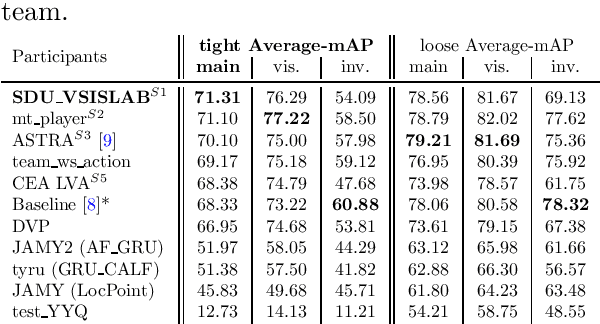


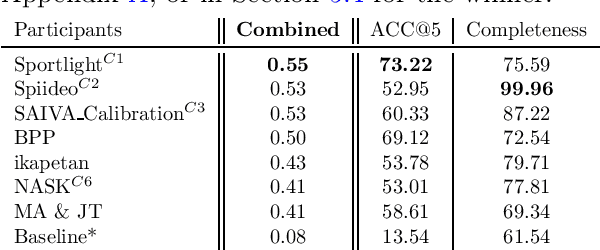
Abstract:The SoccerNet 2023 challenges were the third annual video understanding challenges organized by the SoccerNet team. For this third edition, the challenges were composed of seven vision-based tasks split into three main themes. The first theme, broadcast video understanding, is composed of three high-level tasks related to describing events occurring in the video broadcasts: (1) action spotting, focusing on retrieving all timestamps related to global actions in soccer, (2) ball action spotting, focusing on retrieving all timestamps related to the soccer ball change of state, and (3) dense video captioning, focusing on describing the broadcast with natural language and anchored timestamps. The second theme, field understanding, relates to the single task of (4) camera calibration, focusing on retrieving the intrinsic and extrinsic camera parameters from images. The third and last theme, player understanding, is composed of three low-level tasks related to extracting information about the players: (5) re-identification, focusing on retrieving the same players across multiple views, (6) multiple object tracking, focusing on tracking players and the ball through unedited video streams, and (7) jersey number recognition, focusing on recognizing the jersey number of players from tracklets. Compared to the previous editions of the SoccerNet challenges, tasks (2-3-7) are novel, including new annotations and data, task (4) was enhanced with more data and annotations, and task (6) now focuses on end-to-end approaches. More information on the tasks, challenges, and leaderboards are available on https://www.soccer-net.org. Baselines and development kits can be found on https://github.com/SoccerNet.
FULLER: Unified Multi-modality Multi-task 3D Perception via Multi-level Gradient Calibration
Jul 31, 2023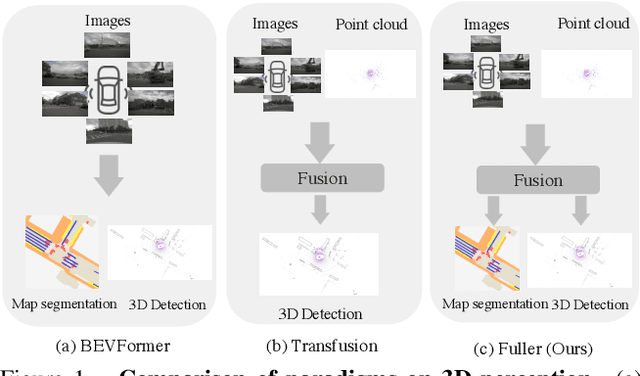
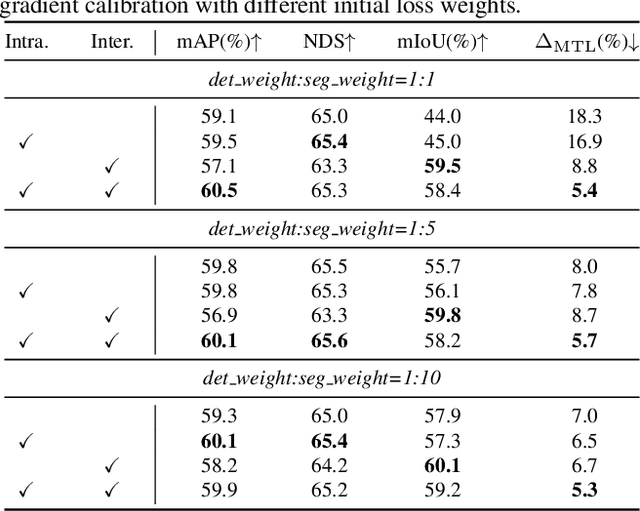

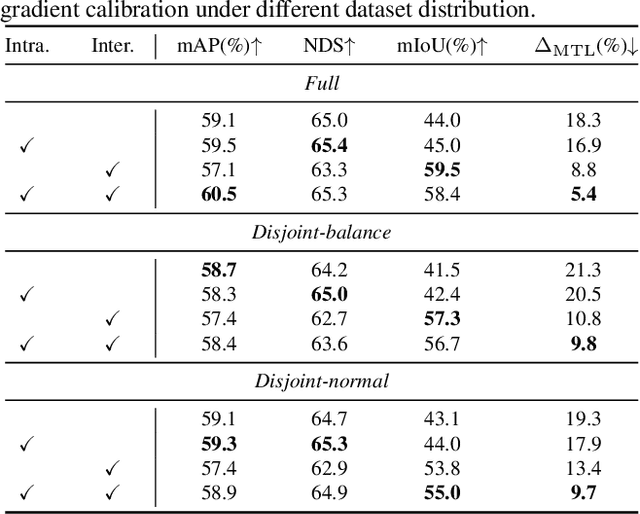
Abstract:Multi-modality fusion and multi-task learning are becoming trendy in 3D autonomous driving scenario, considering robust prediction and computation budget. However, naively extending the existing framework to the domain of multi-modality multi-task learning remains ineffective and even poisonous due to the notorious modality bias and task conflict. Previous works manually coordinate the learning framework with empirical knowledge, which may lead to sub-optima. To mitigate the issue, we propose a novel yet simple multi-level gradient calibration learning framework across tasks and modalities during optimization. Specifically, the gradients, produced by the task heads and used to update the shared backbone, will be calibrated at the backbone's last layer to alleviate the task conflict. Before the calibrated gradients are further propagated to the modality branches of the backbone, their magnitudes will be calibrated again to the same level, ensuring the downstream tasks pay balanced attention to different modalities. Experiments on large-scale benchmark nuScenes demonstrate the effectiveness of the proposed method, eg, an absolute 14.4% mIoU improvement on map segmentation and 1.4% mAP improvement on 3D detection, advancing the application of 3D autonomous driving in the domain of multi-modality fusion and multi-task learning. We also discuss the links between modalities and tasks.
Arch-Graph: Acyclic Architecture Relation Predictor for Task-Transferable Neural Architecture Search
Apr 12, 2022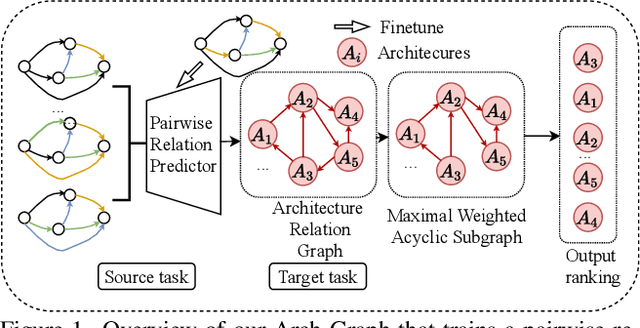
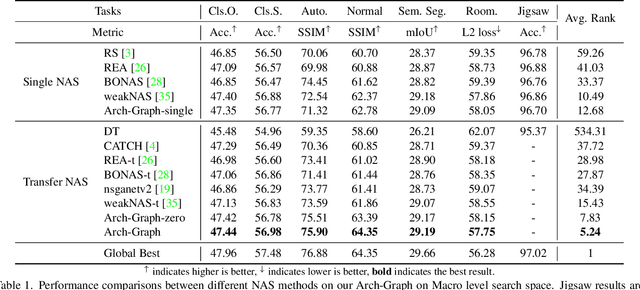

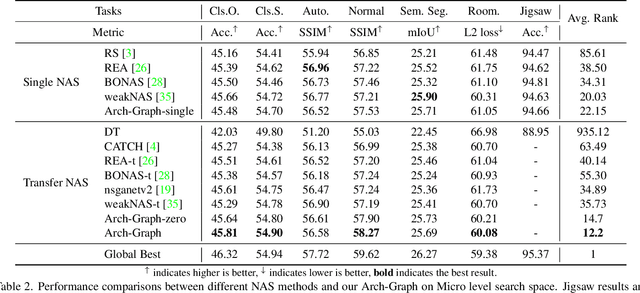
Abstract:Neural Architecture Search (NAS) aims to find efficient models for multiple tasks. Beyond seeking solutions for a single task, there are surging interests in transferring network design knowledge across multiple tasks. In this line of research, effectively modeling task correlations is vital yet highly neglected. Therefore, we propose \textbf{Arch-Graph}, a transferable NAS method that predicts task-specific optimal architectures with respect to given task embeddings. It leverages correlations across multiple tasks by using their embeddings as a part of the predictor's input for fast adaptation. We also formulate NAS as an architecture relation graph prediction problem, with the relational graph constructed by treating candidate architectures as nodes and their pairwise relations as edges. To enforce some basic properties such as acyclicity in the relational graph, we add additional constraints to the optimization process, converting NAS into the problem of finding a Maximal Weighted Acyclic Subgraph (MWAS). Our algorithm then strives to eliminate cycles and only establish edges in the graph if the rank results can be trusted. Through MWAS, Arch-Graph can effectively rank candidate models for each task with only a small budget to finetune the predictor. With extensive experiments on TransNAS-Bench-101, we show Arch-Graph's transferability and high sample efficiency across numerous tasks, beating many NAS methods designed for both single-task and multi-task search. It is able to find top 0.16\% and 0.29\% architectures on average on two search spaces under the budget of only 50 models.
 Add to Chrome
Add to Chrome Add to Firefox
Add to Firefox Add to Edge
Add to Edge